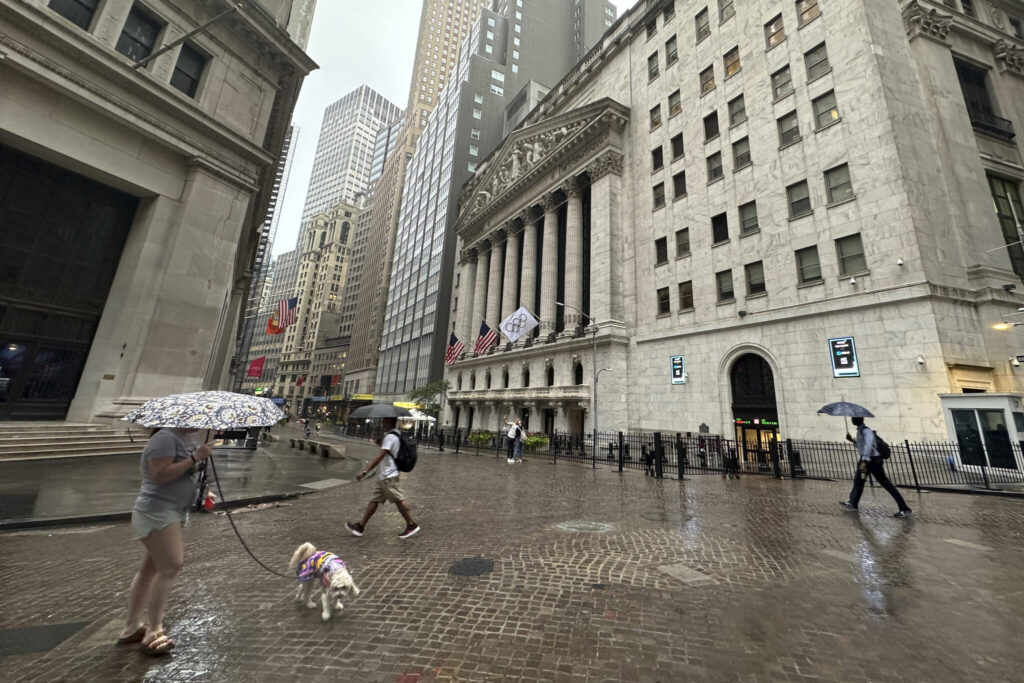U.S. stocks are holding relatively steady on Friday at the tail end of a wild, whipsaw week for Wall Street. The S&P 500 was virtually unchanged in early trading, coming off its best day since 2022. After yo-yoing through several sharp swings, it’s on track to close a fourth straight losing week. That would be its longest such streak in almost a year. The Dow Jones Industrial Average was down 76 points, or 0.2%, and the Nasdaq composite was basically flat. Both are also heading for losing weeks.
Quick Read
- Wall Street holds steady at week’s end after volatile trading:
- U.S. stocks are relatively stable on Friday following a turbulent week, with the S&P 500 virtually unchanged and the Dow Jones Industrial Average down slightly by 76 points.
- The market is on track to close its fourth consecutive losing week, the longest such streak in nearly a year.
- Despite some big companies like Expedia Group reporting better-than-expected profits, concerns about the strengthening Japanese yen and a slowing U.S. economy continue to weigh on the market.
- The 10-year Treasury yield fell to 3.93%, reflecting investor worries and a shift towards safer assets amid speculation of potential rate cuts by the Federal Reserve.
- Upcoming reports on U.S. retail spending and inflation next week could further influence market volatility.
The Associated Press has the story:
Wall Street is waffling at the close of its wild, whipsaw week
Newslooks- NEW YORK (AP) —
U.S. stocks are holding relatively steady on Friday at the tail end of a wild, whipsaw week for Wall Street. The S&P 500 was virtually unchanged in early trading, coming off its best day since 2022. After yo-yoing through several sharp swings, it’s on track to close a fourth straight losing week. That would be its longest such streak in almost a year. The Dow Jones Industrial Average was down 76 points, or 0.2%, and the Nasdaq composite was basically flat. Both are also heading for losing weeks.
The drops came even though more big U.S. companies piled on to the group that’s reported better profit for the spring than analysts expected. Expedia Group jumped 9% after delivering stronger results than expected, though like some other companies it said it saw a softening of demand in July. Wall Street’s losses followed a mixed performance for stocks worldwide, which have also been frenetic this week because of a number of factors slamming into markets all at once. At the forefront is the value of the Japanese yen, whose sudden and sharp strengthening recently has forced hedge funds and other traders around the world to scramble out of a popular trade en masse.
They had been borrowing Japanese yen at very low cost and then investing it elsewhere around the world, but a rate hike by the Bank of Japan forced many to abandon the trade at the same time. A promise by a top Bank of Japan official in the middle of the week not to raise rates as long as markets are “unstable” helped to stabilize the yen, but its value climbed against the U.S. dollar in morning trading. That helped undercut gains for U.S. stock futures, which had earlier been indicating Wall Street was set for a higher open on Friday.
Also weighing on the market have been worries about the slowing U.S. economy. A raft of weaker-than-expected reports has forced questions about whether the Federal Reserve has kept interest rates at too high of an economy-crunching level for too long in order to beat inflation. Last week’s report showing much weaker hiring by U.S. employers than expected was the lowlight. Such worries dragged Treasury yields lower in the bond market this week, and they fell again Friday as investors looked for safer places for their money. Expectations have also built for deeper cuts to rates coming from the Fed, starting with an anticipated cut at its next meeting next month.
The yield on the 10-year Treasury fell to 3.93% from 3.99% late Thursday. But it’s still well above the 3.70% level that it briefly sank to on Monday when fear was surging and investors were speculating the Fed may even have to call an emergency meeting to cut rates. Reports next week could drive even more swings. On Thursday will come updates on how much shoppers are spending at U.S. retailers. Households at the lower end of the income spectrum have been struggling to keep up with still-rising prices, but economists expect the report to show a return to growth in spending after a stall in June.
Looming over it will be the latest updates on inflation. A worst-case scenario for markets would have Tuesday’s and Wednesday’s updates on inflation at the wholesale and consumer levels show higher-than-expected inflation at the same time the economy is weakening.







